What’s that? You got in a fight? And you won? That’s very impressive of you. Whom did you fight? Was it—a human being?
Yawn.
Fighting humans, even very large ones, is hardly an impressive feat. Humans have been fighting humans since humans have been humans. You think you’re so tough because you whupped one’s ass? You’re not tough. You’re not strong. You’re nothing. You’re nothing until you fight a train.
That’s right. A real man doesn’t fight other men. He fights trains. And when a man fights a train, which you must admit is a rather imposing sort of thing to go around fighting, it’s one hell of an accomplishment, all the more so because, as it turns out, to fight a train is not actually to fight a train.
It’s to fight yourself.
I know, this is getting confusing. But that’s life for you. If you want to be a man, you’re going to have to fight a train, which train is you. More confusing still—if you win, you lose.
But don’t despair! For you see, in the end, losing is really winning. Got it? No? That’s okay. We’re here to help.
In this week’s Mind Control Double Feature we encounter two men more manly than ever you dared to dream a man could be, and watch them take on locomotives with their bare hands!
Emperor of The North (1973)
It was joked during the Great Depression that the world’s best hobo was the Emperor of the North Pole, free to rule his empty frozen wasteland. They found this rather hilarious. Hobos needed a sense of humor in those days. Polite society found them less than appealing.
But society at large wasn’t the hobo’s worst enemy. That title goes to—train conductors. Because if there’s one thing a train conductor hates, it’s a freeloader, and how did hobos travel the country? By hopping trains.
Emperor of The North (origially with “Pole” in the title, but I guess they decided that was too long (or that people would think it was a movie about Santa Claus?)), set in the dark days of ’33, is about the battle between the world’s most sadistic conductor and the world’s greatest hobo.
The hobo, known as A-No. 1 (not to be confused with the Duke of New York), is played by Lee Marvin. He is the most bad-ass hobo of all time, of that there is no doubt. He’s Lee Marvin, after all.
The conductor, known as Shack, is played by Ernest Borgnine. He walks down and back across the roof of his moving train, the No. 19, wielding a hammer. When he finds a hobo hanging out between cars, he beats the man over the head, sending him to the tracks and his death. That’s how we meet Shack.
A-No. 1 we meet hopping a very brief ride on the No. 19. He’s caught because another hobo, a young amatuer in the ways of hoboism, Cigaret (Keith Carradine), hops on with him. Shack locks them in a hay car, trapped until they reach the station and can be dealt with appropriately (killed? The possibility is intimated). But never fear. A-No. 1 just sets the car on fire with a cigar and crashes out through its half-burned, flaming slat walls. Lee Marvin, remember?
After that, the story is simple. A-No. 1 announces that he’s going to ride the No. 19 all the way to Portland. Cigaret says the same. Shack knows it’s on, because the hobos write on station water towers the trains they intend to hop.
And so, the battle begins.
Emperor of The North (directed by Robert Aldrich, of Kiss Me Deadly and The Dirty Dozen fame (and Twilight’s Last Gleaming, but let’s forget about that one)), is an odd bird. In large part, it functions like many movies of its era, as two mismatched men, outcast from society at large, forge an unlikely friendship, in the case the old, wise hobo and the fast-talking, know-nothing youngster, at first enemies, and later—
Only no, this isn’t that movie. Things don’t work out so predictably beween these two guys.
Meanwhile, there’s Shack, who’s pure evil, in a way neither funny nor charming. This guy means business. He will outright murder you he finds you on his train. He doesn’t much care about Cigaret. He knows the real hobo is A-No. 1. That’s the man he’s at war with.
The first part of the movie you almost think this is a lighthearted affair of sorts. Well, yes, aside from the hobo murdering. The intros to the world of train workers and the world of hobos is almost, but not quite, silly. Numerous weirdly bouncy musical interludes crop up, and one thinks maybe this is more a buddy picture after all.
Yet by the end, things become very serious indeed. A-No. 1 is going to beat the No. 19 no matter what. We don’t realize how serious he is until we reach the finale. When A-No. 1 fights Shack, there’s no CGI supermen throwing each other into buildings. It’s two men on a moving train, fighting with a hammer, a 2×4, a length of chain, and an axe. It’s serious. It hurts.
Who will be the Emperor of The North Pole? What will it be like when he gets there? And what will be his fate? The answer lies in our second feature:
Runaway Train (1985)
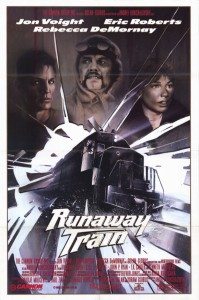 Alaska might not be quite the North Pole, but it’s a perfectly respectable icy wasteland. Runaway Train opens in a maximum security prison in which Oscar “Manny” Manheim (John Voight) is being released from solitary confinement per a court order. Warden Ranken (John P. Ryan) had him welded in his cell for three years, punishment for having tried to escape. Ranken knows Manny’s going to try to escape again. Everyone knows it. Manny is a hero to the other prisoners, especially young Buck (Eric Roberts), who desperately wants Manny to take him along. Manny wastes no time. He and Buck bust out, into the snowy wilderness, and hop a train.
Alaska might not be quite the North Pole, but it’s a perfectly respectable icy wasteland. Runaway Train opens in a maximum security prison in which Oscar “Manny” Manheim (John Voight) is being released from solitary confinement per a court order. Warden Ranken (John P. Ryan) had him welded in his cell for three years, punishment for having tried to escape. Ranken knows Manny’s going to try to escape again. Everyone knows it. Manny is a hero to the other prisoners, especially young Buck (Eric Roberts), who desperately wants Manny to take him along. Manny wastes no time. He and Buck bust out, into the snowy wilderness, and hop a train.
Yes, it’s the old, wise con, and the fast-talking, know-nothing youngster, forging an unlikely friendship on a moving train—
Or, then again, not so much. Like Emperor of The North, this isn’t a buddy movie. It’s about two men, in this case Manny and Ranken, battling for supremacy, and doing it on a train. Buck, like Cigaret, is merely along for the ride.
Runaway Train is based on an original screenplay by Akira Kurosawa. He was never able to make it, but director Andrei Konchalovsky does a damn fine job. Granted, I’d kill anyone you put in front of me to watch this movie directed by Kurosawa, starring Toshiro Mifune, but alas, tis not to be. As it is, Runaway Train is one of the best action movies of the ‘80s.
So our heroes jump a train, but of all the luck, the conductor has a heart attack and drops dead. It’s a runaway train, unbeknownst to Manny and Buck.
They find a lone employee aboard, Sara (Rebeccas DeMornay), who’d fallen asleep on the job. She explains the situation. The train is going way too fast and no one’s left to drive it. There’s no way to get to the engine car, either.
Meanwhile, at mission control, or whatever they call it for trains, there’s a subplot about some weasily smart guy who designed a computerized system to control the trains, blah blah blah, and now there’s a runaway, and oh hell, what to do? These scenes are less inspiring than everything with Voight, but so it goes.
Of course the movie is not about a runaway train, and it’s not about an unlikely friendship, and it’s not about ill-advised computer software. It’s about Manny’s fight against fate. Manny is the runaway train. Unfortunate, then, for Warden Ranken, who’s made it his life’s work to put a stop to anyone who dares defy his power. He’s going to find going up again Manny an ill-advised decision.
John Voight gives one of his greatest performances in Runaway Train. He is an animal, an all too human animal, who refuses to be caged—not by a cell, not by a train, not by death. If anyone’s going to be emperor of the north pole, it’s him.

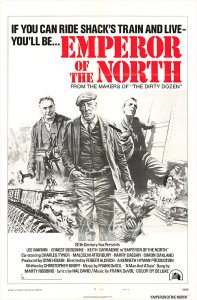
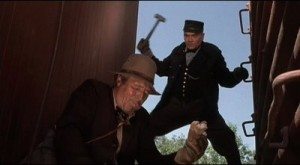
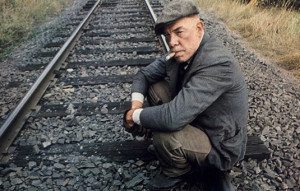
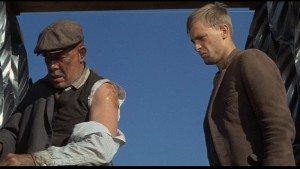
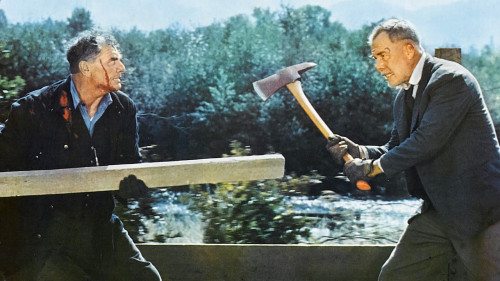
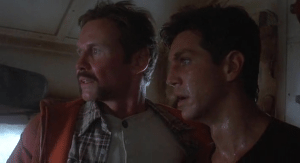
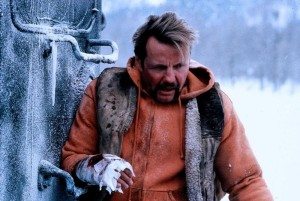
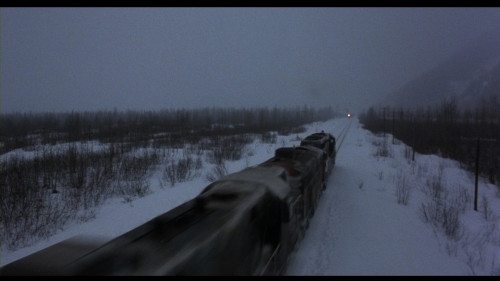
Both films evoke strong memories and entice to think about their stories. Emperor of the North with its depiction of hobo lives is something that doesn’t go that far back into the past if you look at numbers and yet I wonder who nowadays really remembers hoboes. They once apparently characterized America in this specific period and economic circumstances. But when I talked about hoboes some time ago with my much younger colleagues in London, none of them had ever heard of them! That’s one of the great things about good films: you can tell these people, go and watch that flick and you’ll get an excellent impression of what a hobo is. More than any history book ever good provide!
Runaway train is a flick I watch four or five times and it never gets stale. It grips you with all your senses, a literal tour de force. And I agree, if John Voight was great in Asphalt Cowboy, then he was absolutely smashing in Runaway Train. I remember being transfixed to the screen. Thanks for the wonderful memories your review evoked.
On a totally unrelated note: I very much like the latest version of your blog title image. It is spot on with that 50s SciFi B-movies font applied to perfection.This definitely hits the right note!
Thank you Trinity!
As you noticed, I’ve been working on this for a while now. I do believe we have finally found a winner. The font, of course, is called “Them!”
I have not seen Emperor of the North, but Runaway Train is an incredible film. It is a movie that, like Rollerball and The Duellists (Ridley Scott’s first film), stresses the concept of “men doing what men do”…not for any greater glory, or duty or even any sort of honor, but merely because they are unrelenting and unyielding.